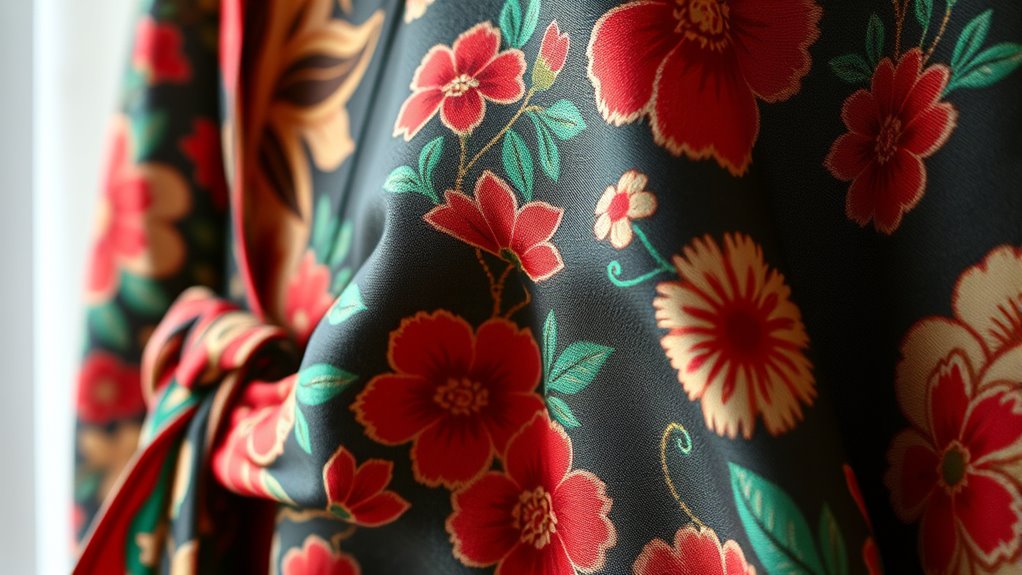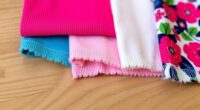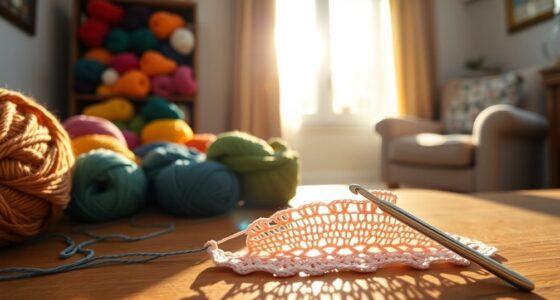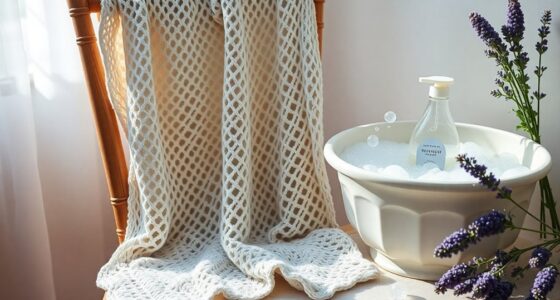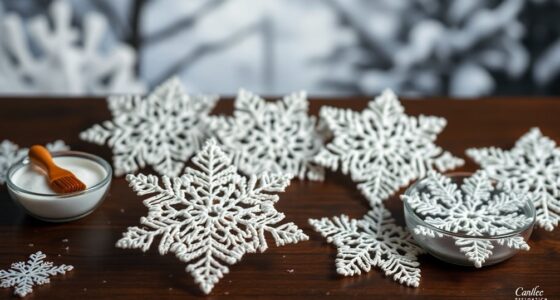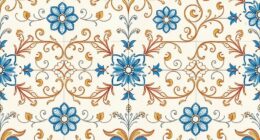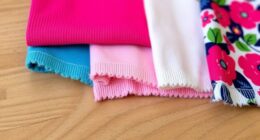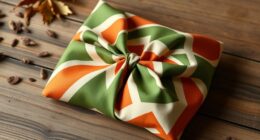Transform your old curtains into a stunning statement kimono by selecting breathable, textured fabrics and dyeing them with eco-friendly methods to add vibrant colors. Use sustainable sewing practices and minimal waste techniques to assemble your garment, then personalize it with patches or embroidery for a unique touch. Emphasizing eco-conscious fashion, you turn discarded textiles into wearable art that reflects your style and values. Keep exploring to discover detailed steps for creating your own upcycled fashion piece.
Key Takeaways
- Select and clean curtain fabrics suitable for kimono styles, considering texture, flow, and durability.
- Use eco-friendly dyeing techniques to customize colors and rejuvenate faded textiles before sewing.
- Incorporate sustainable sewing practices with recycled notions and precise cutting to minimize waste.
- Personalize the kimono with decorative elements like embroidery or fabric paints for a unique statement piece.
- Finish with durable, eco-conscious details to create a stylish, environmentally friendly garment from discarded textiles.

Upcycling home textiles is a creative way to give new life to old fabrics while reducing waste. When you transform a worn-out curtain into a stylish kimono, you’re not just creating a unique garment—you’re also making an eco-friendly statement. This process begins with selecting the right fabric, often leftover or outdated home textiles, that can be repurposed into fashionable wear. The first step involves fabric dyeing, where you can customize the material’s color to match your style or to breathe new life into faded or stained textiles. Using eco-friendly dyes guarantees your project stays sustainable, avoiding harmful chemicals that can damage the environment. As you dye your textiles, you have the opportunity to experiment with different shades and techniques, turning plain fabric into something vibrant and personal.
Once the fabric is dyed, it’s time for eco-friendly sewing. This means choosing sustainable materials like organic threads or recycled notions, and employing sewing methods that minimize waste. You can keep the original texture and pattern of the fabric, or cut and reshape it into new forms that suit your design. For example, a curtain’s flowing fabric lends itself beautifully to loose, comfortable kimono styles. By carefully measuring and cutting, you ensure minimal fabric waste, making your upcycling project as sustainable as possible. Eco-friendly sewing isn’t just about the materials; it’s also about the process. You might opt for hand sewing or low-impact machine stitching, which reduces energy consumption and prolongs the life of your textiles. Incorporating contrast ratio considerations can help you visualize how different fabric textures and colors will come together for a balanced and appealing final look.
As you assemble your kimono, pay attention to details like seams, hems, and finishing touches that enhance durability and style. Upcycling isn’t just about reusing fabric—it’s about creating something uniquely yours. You can add decorative elements like patches, embroidery, or even fabric paints to further personalize your piece. The beauty of this project lies in its versatility: a simple curtain can become a statement garment that reflects your creativity and commitment to sustainability. By choosing eco-friendly sewing practices and fabric dyeing techniques, you’re not only reducing waste but also supporting a more conscious approach to fashion. The result is a one-of-a-kind kimono that embodies your personality while respecting the environment. This process transforms discarded textiles into wearable art, proving that sustainable fashion can be both stylish and meaningful.
Frequently Asked Questions
What Tools Are Essential for Upcycling Home Textiles?
To upcycle home textiles, you need essential tools like sharp scissors for fabric cutting and a sewing machine to apply various sewing techniques. Fabric dyeing supplies, such as dyes and brushes, help you add color and character. Measuring tape guarantees accurate cuts, while pins and needles secure your pieces. With these tools, you can transform old curtains or textiles into stylish statement wear, giving new life to your home fabrics through creative sewing and dyeing.
How Do I Choose the Right Textiles for Clothing?
When choosing textiles for clothing, focus on fabric durability to guarantee your garments last, especially if you plan to wear them often. Look for textiles with patterns that match your style and complement your wardrobe. Avoid fragile fabrics that might tear or wear out quickly. By considering both durability and patterns, you can select textiles that are both practical and stylish, making your upcycled wear truly stand out.
Can Old Curtains Be Turned Into Waterproof Garments?
Think of your old curtains like a sturdy shield—can they become waterproof garments? With fabric waterproofing treatments, you can enhance their textile durability and make them more resistant to water. However, not all curtains are suitable; heavy or delicate fabrics may not hold up well. So, if your curtains are made of durable, tightly woven fabric, you can upcycle them into waterproof jackets or raincoats with the right treatment.
What Are Common Challenges in Textile Upcycling Projects?
When you tackle textile upcycling projects, common challenges include sourcing sustainable materials and mastering upcycling techniques. You might struggle to find eco-friendly fabrics or materials that match your project’s needs. Additionally, applying proper techniques guarantees durability and quality, which can be tricky. Staying committed to sustainable sourcing and continuously honing your upcycling skills helps overcome these obstacles, making your upcycled creations both eco-conscious and stylish.
How Do I Maintain the Quality of Upcycled Clothing?
To keep your upcycled clothing pristine, prioritize proper textile preservation. Wash items gently, avoiding harsh detergents, and air dry when possible. Handle fabrics carefully during sewing or alterations to prevent damage. By maintaining meticulous care, you support sustainable fashion and ensure your creative creations stay charming and chipping-chic longer. Consistent care keeps your upcycled pieces looking fresh, fashionable, and fabulous, blending brilliance with eco-consciousness.
Conclusion
By transforming old curtains and kimonos into statement clothing, you not only give new life to worn-out textiles but also make a stylish eco-friendly choice. Did you know that upcycling reduces waste by up to 70% compared to traditional disposal? So, next time you see a cast-off fabric, think about turning it into something unique. Embrace sustainable fashion—your wardrobe (and the planet) will thank you for it!
